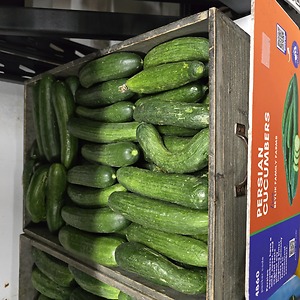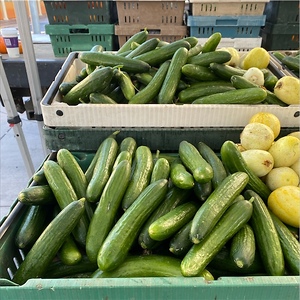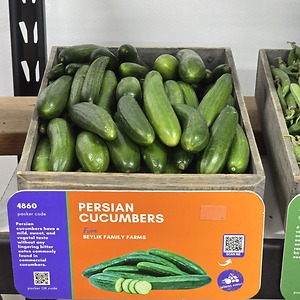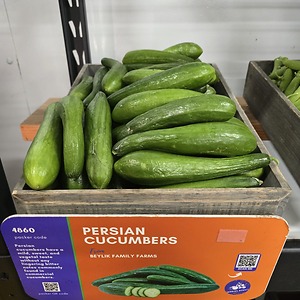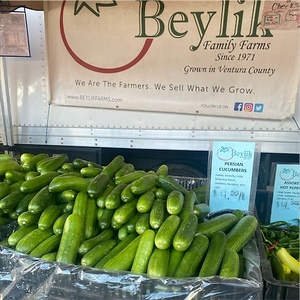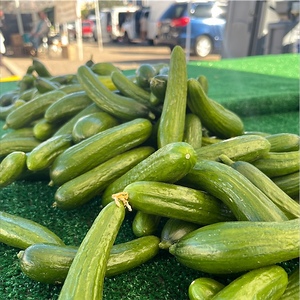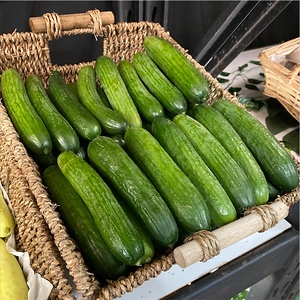

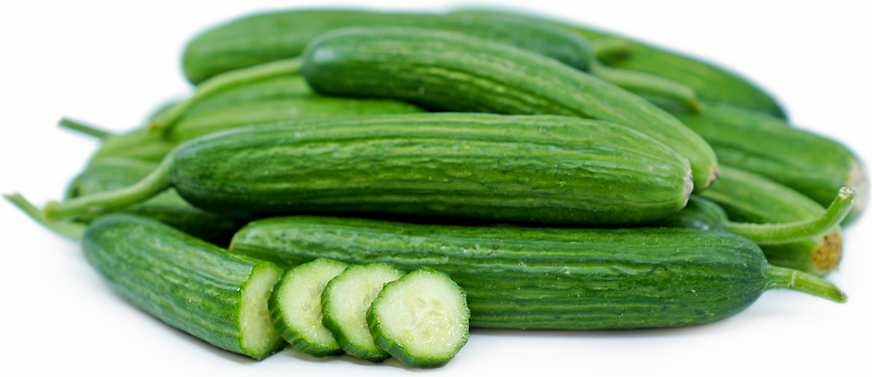
Persian Cucumbers
Estimated Inventory, 20 lbs : 65.60
This item was last sold on : 07/13/25
Description/Taste
Persian cucumbers are small in size, averaging 10 to 15 centimeters in length, and have a narrow, cylindrical appearance with curved, blunt ends. The cucumbers can be straight or have a slight curve to their shape, and the skin is thin, emerald to dark green, and tender, sometimes smooth or covered in shallow ridges. Underneath the skin, the pale green flesh is dense, aqueous, and firm with a succulent, crisp, and crunchy, snap-like consistency. The flesh also encases a central core filled with underdeveloped pale green seeds. These seeds are edible and often go unnoticed when consumed fresh. The flesh is characteristically crunchier and less watery than other varieties, and the cucumbers release a faint green aroma when sliced. Persian cucumbers have a mild, sweet, and vegetal taste without any lingering bitter notes commonly found in commercial cucumbers.
Seasons/Availability
Persian cucumbers are available year-round.
Current Facts
Persian cucumbers, botanically classified as Cucumis sativus, is the name of a category of small cucumber varieties belonging to the Cucurbitaceae family. The crisp, sweet, and mild cucumbers were developed in the Middle East in the early to mid-20th century and were designed as an improved class of cucumbers that had quality flavor, texture, and disease resistance. Persian cucumbers grow on vining plants extending over one meter across support structures, and the plants are vigorous, producing a continuous crop of fast-maturing, early-harvested cucumbers. The plants thrive in cool and warm growing regions and are parthenocarpic, meaning the vines can produce fruits without the need for pollination. This characteristic gives the cucumbers their almost seedless flesh. Persian cucumbers also have thin, easily digestible skin, contributing to their burpless nature. There are many different varieties of Persian cucumbers, including Figaro, Cordito, Socrates, Picolino, Katrina, Ishtar, Iznik, and Manar. These cultivars are also found in markets generally labeled as Middle Eastern, Lebanese, Beit Alpha, Beit Alfa, Mini-Cucumber, and Green Baby Fingers. In the modern day, the name Persian cucumber is a blanket term used for small versatile cucumbers from northern Israel, utilized fresh or cooked, maintaining a crisp consistency and mild, sweet, vegetal nature.
Nutritional Value
Persian cucumbers are a source of fiber to regulate the digestive tract, vitamin C to strengthen the immune system, and potassium to balance fluid levels within the body. The cucumbers also provide manganese and vitamin K to assist in faster wound healing, antioxidants to protect the cells against damage caused by free radicals, and other nutrients, including vitamin A, silica, iron, and calcium.
Applications
Persian cucumbers have a mild, sweet, and vegetal taste suited for fresh and cooked preparations. The small cucumbers can be eaten straight out of hand and are popularly sprinkled with salt for enhanced flavoring. Persian cucumbers can also be chopped into salads as their mild taste complements more potent ingredients such as raw onions, herbs, nuts, and yogurt, or they can be minced into dressings, sliced into fresh spring rolls, or used as a dipping vessel on appetizer platters. Try chopping Persian cucumbers into salsas or adding them to grain bowls as a crunchy element. In addition to fresh preparations, Persian cucumbers as used as a cooling ingredient in spicy dishes and added to stir-fries, roasted meats, curries, or rice-based dishes. The cucumbers can also be incorporated into cold soups, used as a fresh pizza topping, or cooked as a side dish with other vegetables. In Iran, Persian cucumbers are chopped and mixed into salad shirazi, a fresh dish comprised of cucumbers, tomatoes, lemon juice, mint, parsley, and red onion. Cucumbers are also incorporated into mast-o-khiar, a Persian cucumber and herb yogurt dip. Beyond culinary dishes, Persian cucumbers can be pressed into juice and used to flavor cocktails, blended and frozen into herb-infused popsicles, or pickled for extended use. The cucumbers can be used in any recipe calling for cucumbers, especially English cucumbers, as they share a similar flavor. Persian cucumbers pair well with herbs such as mint, parsley, and cilantro, spices including cumin, coriander, and curry powder, citrus, jicama, watercress, sprouts, and cheeses such as chevre, feta, and cotija. Whole, unwashed Persian cucumbers will keep up to one week when wrapped in a paper towel and stored in a sealed container in the refrigerator's crisper drawer.
Ethnic/Cultural Info
Persian cucumbers are favored for their cooling nature and are utilized in natural home remedies. In the Middle East, cucumbers are considered a diuretic to cleanse the body of toxins, and cucumber juice is also applied topically to the skin as a soothing cleanser. Persian cucumbers received their cooling status from their high-water content, and the traditionally chilled fruits are viewed as a method to reduce heat from the body externally and internally. Throughout history, cucumbers have developed a cooling reputation across many cultures, and in the 18th century, they were used in the famous English idiom "as cool as a cucumber." This expression first appeared in the poem "New Song on New Similes" written by John Gay. In 1732, the British poet wrote, "Cool as a cucumber could see the rest of womankind," and this phrase was alluding to the human embodiment of cucumber characteristics. Cucumbers are typically cool to the touch, even in hot weather, and are used to describe a person who remains collected, calm, and composed in stressful, high-pressure circumstances. Since its creation, the English idiom has remained a part of everyday dialogues and is used to describe many different situations.
Geography/History
Persian cucumbers were developed in the early to mid-20th century through traditional breeding techniques in the Beit Alpha kibbutz in northern Israel. The kibbutz was established in 1922 on the Jezreel Plain at the foot of Mount Gilboa and was one of the first kibbutzim to have been constructed in Palestine, now northern Israel, in the modern day. The kibbutz was founded by members of the Socialist-Zionist organization known as Hashomer Hatzair, and in 1931, kibbutz member Hanka Lazarson began breeding improved cucumber varieties. Lazarson started with the Damascus cucumber, a local variety, and began naturally crossing it with other cucumbers, planting the vining plants in the fertile soil of the Harod Valley in lower Galilee. The small cucumbers exhibited improved flavor and size, but they were susceptible to disease, preventing them from being grown widely. Lazarson distributed seeds to regional farmers in 1936. For several years, cucumber varieties carried from China, Japan, Surinam, India, and the United States were crossbred with the variety to improve disease resistance. The cucumbers were also bred with Dutch and English varieties to create a seedless nature. The improved cucumbers were initially named Beit Alpha cucumbers after their site of origination in 1939, and over time, the cucumbers were also given general monikers of Lebanese, Middle Eastern, and Persian cucumbers. Today Persian cucumbers have been spread worldwide and were initially carried to other countries by migrating peoples. Persian cucumbers are grown in fields and greenhouses and are commercially produced in Europe, Asia, Australia, and the United States. There are large-scale production greenhouses in Baja California and Canada. In the United States, Persian cucumbers are a specialty variety planted in Southern California and are primarily found through farmer's markets, select grocers, and distributors.
Featured Restaurants
Restaurants currently purchasing this product as an ingredient for their menu.
| Mothership | San Diego CA | 858-342-3609 |
| AKA | San Diego CA | 619-595-1450 |
| Solare Ristorante Lounge | San Diego CA | 619-270-9670 |
| 31ThirtyOne by Deckman | San Diego CA | 619-495-9814 |
| Bekker's Catering | San Diego CA | 619-287-9027 |
| Menya Ultra (La Jolla) | San Diego CA | 619-632-2704 |
| Marriott Courtyard - Broadway | San Diego CA | 619-446-3008 |
| The Crack Shack Costa Mesa | Costa Mesa CA | 951-808-7790 |
| Urban Kitchen Catering | San Diego CA | 619-276-8803 |
| Toast Catering | San Diego CA | 619-795-9135 |
| Revolution Roasters | Oceanside CA | 760-330-6827 |
| The Switchboard Restaurant 2024 | Oceanside CA | 760-279-6300 |
| Parisien Gourmandises | La Jolla CA | 858-352-6552 |
| Il Giardino di Lilli | La Jolla CA | 619-467-9897 |
| Ballast Point Rest. - Miramar | San Diego CA | 858-790-6900 |
| Menya Ultra (Mira Mesa) | San Diego CA | 619-889-4566 |
| Stone Brewing World Bistro & Gardens | Escondido CA | 915-861-2297 |
| Better Buzz Coffee (La Jolla) | La Jolla CA | 619-269-4022 |
| Born & Raised | San Diego CA | 619-944-1631 |
| Junkyard Sports Bar and Grill | Oceanside CA | 760-407-8500 |
| Barra Oliba | San Diego CA | 610-310-5110 |
| Cellar Hand | San Diego CA | 334-689-2388 |
| Lodge at Torrey Pines Grill | San Diego CA | 858-453-4420 |
| Hotel La Jolla - Sea & Sky | La Jolla CA | 858-459-0261 |
| Terra Restaurant | San Diego CA | 619-293-7088 |
| Black Radish | San Diego CA | 619-775-7412 |
| Aztec Shop Catering | San Diego CA | 619 594-3576 |
| Milton's Delicatessen, Grill & Bakery | Del Mar CA | 858-792-2225 |
| Fortunate Son | San Diego CA | 619-806-6121 |
| Temaki | Encinitas CA | 702-489-2129 |
| Bar Same Same (Kitchen) | Carlsbad CA | 760-470-9143 |
| The Plot Restaurant (Costa Mesa) | Costa Mesa CA | 714-852-3181 |
| Jeune Et Jolie | Carlsbad CA | 858-231-0862 |
| Gold Finch | San Diego CA | 619-804-2051 |
| Dot Cafe | San Diego CA | 914-263-1424 |
| Hane | San Diego CA | 619-339-6438 |
| Miho (Bar) | San Diego CA | 619-867-4295 |
| Green Acres Campus | San Diego CA | 858-450-9907 |
| Piatti | San Diego CA | 858-454-1589 |
| Miho | San Diego CA | 619-365-5655 |
| Rustic Root Solana | Solana Beach CA | 619-955-5750 |
| The Taco Stand | San Diego CA | 619-549-9919 |
| Olive Tree Marketplace | San Diego CA | 619-224-0443 |
| Mabel's Gone Fishing | San Diego CA | 619-228-9851 |
| Black Raill Kitchen + Bar | Carlsbad CA | 619-454-9182 |
| Vertex - Merryfield Row | San Diego CA | 619-405-8950 |
| Grass Skirt | San Diego CA | 858-412-5237 |
| Javier Plascencia | Bonita CA | 619-295-3172 |
| Q&A Oyster Bar & Restaurant | Oceanside CA | 858-245-3780 |
| Alila Marea (VAGA Bar) | Encinitas CA | 805-539-9719 |
| Stone Brewing-Liberty Station | San Diego CA | 619-269-2100 |
| The Handmade Chef Meal Prep Co. | San Diego CA | 619-368-3705 |
| The Pearl Hotel | San Diego CA | 877-732-7573 |
| Harumama Noodles & Buns (Vista) | Vista CA | 858-886-9909 |
| Sushi Tadokoro | San Diego CA | 619-347-2792 |
| Pizzeria Luigi | San Diego CA | 610-539-7025 |
| Communal Coffee - Fern St. | San Diego CA | 619-305-9525 |
| Marriott Courtyard Nolen | San Diego CA | 619-544-1004 |
| InterContinental Vistal Kitchen | San Diego CA | 619-501-9400 |
| Love Boat Sushi-Oceanside | Oceanside CA | 760-721-3737 |
| Panama 66 | San Diego CA | 619-206-6352 |
| Food of Joy | San Diego CA | 858-531-6616 |
| The Bower | Coronado CA | 949-212-3192 |
| The Cottage Encinitas | Encinitas CA | 858-454-8409 |
| Palmys | San Diego CA | 858-886-7111 |
| Bridges at Rancho Santa Fe | Rancho Santa Fe CA | 858-759-6063 |
| Hawaiian Fresh Seafood | San Diego CA | 858-299-8862 |
| Communal Coffee - Oceanside | Oceanside CA | 619-920-7887 |
| Snake Oil Cocktail Company LLC | San Diego CA | 619-754-4041 |
| Pendry SD | San Diego CA | 619-738-7000 |
| Ron Oliver | San Diego | 619-295-3172 |
| The Crack Shack PB | San Diego CA | 619-450-7978 |
| The Crack Shack-Encinitas | Encinitas CA | 877-230-1871 |
| Choi's | San Diego CA | 858-900-1224 |
| Institutes of Health LLC | San Diego CA | 800-270-5016 |
| Claytons Bakery & Bistro | Coronado CA | 619-435-5425 |
| Daffodil Cafe | San Diego CA | 858-461-7788 |
| Venissimo Cheese North Park | San Diego CA | 619-376-1834 |
| Brockton Villa Restaurant | San Diego CA | 858-454-7393 |
| The Whaling Bar | La Jolla CA | 858-355-9218 |
| Scrimshaw Coffee | San Diego CA | 951-663-2207 |
| Coco Maya by Miss Bs | San Diego CA | 858-245-3780 |
| Little Lion | San Diego CA | 619-519-4079 |
| Chef Sebastian LLC | La Jolla CA | 858-740-0878 |
| Blue Water Estate Services | Rancho Santa Fe CA | 858-720-9831 |
| Park Hyatt Aviara (Ember & Rye) | Carlsbad CA | 760-448-1234 |
| Sandpiper Wood Fired Grill & Oysters | La Jolla CA | 858-228-5655 |
| Lafayette Hotel - Beginners Diner | San Diego CA | 619-296-2101 |
| Barleymash | San Diego CA | 619-255-7373 |
| UCSD Food & Nutrition Department La Jolla | San Diego CA | 858-761-1269 |
| The Remy | San Diego CA | 619-886-1358 |
| Huntress | San Diego CA | 619-955-5750 |
| Common Theory Chula Vista | Chula Vista CA | 619-495-3689 |
| Copper Kings | San Marcos CA | 323-810-1662 |
| Kettner Exchange | San Diego CA | 909-915-9877 |
| C 2 C | San Diego CA | 619-972-9345 |
| The Crack Shack-San Diego | San Diego CA | 619-795-3299 |
| Claire's on Cedros - SKSB | Solana Beach CA | 858-259-8597 |
| Cucina Enoteca | Del Mar CA | 619-239-2222 |
| Neighborhood Burger | San Diego CA | 619-446-0002 |
| Blue Ocean La Jolla | La Jolla CA | 858-999-0323 |
| The Cottage Del Mar | Del Mar CA | 858-775-1197 |
| Rust General Store | San Diego CA | 619-295-7878 |
| The Lion Share 2025 | San Diego CA | 619-564-6924 |
| Panama 66 (Bar) | San Diego CA | 619-702-6373 |
| Leu Leu | Leucadia CA | 619-316-5807 |
| Salt and Lime | Del Mar CA | 858-926-8582 |
| Venissimo Cheese Del Mar | Del Mar CA | 858-847-9616 |
| Happy Medium SD | San Diego CA | 509-869-2279 |
| Corbeaux Wine & Tea House | Temecula CA | 909-567-6109 |
| Boujiemana (La Maison) | San Diego CA | 415-710-0510 |
| Pendry SD (Provisional) | San Diego CA | 619-738-7000 |
| Fishery - Bar | San Diego CA | 858-272-9985 |
| Candor | La Jolla CA | 858-581-2205 |
| Pretty Pickled, Pretty Sauced | National City CA | 619-869-9921 |
| Sheraton Carlsbad (20/20) | Carlsbad CA | 760-827-2400 |
| Azuki Sushi Lounge | San Diego CA | 619-238-4760 |
| UCSD La Jolla (Pritikin Intensive) | San Diego CA | 858-657-6473 |
| Cody's La Jolla | La Jolla CA | 858-459-0040 |
| El Sueno (TAKO) | San Diego CA | 619-972-6286 |
| Coastal Cuisine | San Diego CA | 619-398-8900 |
| Books and Records | San Diego CA | 619-310-5298 |
| The Original 40 Brewing | San Diego CA | 619-206-4725 |
| Botanica | San Diego CA | 619-310-6320 |
| Gravity Heights Restaurant and Brewery | San Diego CA | 858-551-5105 |
| Rancho Valencia | Del Mar CA | 858-756-1123 |
| Trust Restaurant | San Diego CA | 609-780-7572 |
| Waverly | Cardiff CA | 619-244-0416 |
| Catania La Jolla | La Jolla CA | 619-884-5350 |
| Shimbashi Izakaya | Del Mar CA | 858-523-0479 |
| Harumama Sushi & Ramen (Ocean Beach) | San Diego CA | 858-886-9909 |
| Dr Bronner's Magic Soaps | Vista CA | 760-975-7327 |
| Little Victory Wine Market | Carlsbad CA | 310-738-3380 |
| Steady State Roasting | Carlsbad CA | 760-908-1680 |
| The Joint | San Diego CA | 619-222-8272 |
| The Seabird Resort | Oceanside CA | 442-222-9505 |
| The Beau Hotel | San Diego CA | 619-310-5160 |
| Manna | Encinitas CA | 510-366-3057 |
| Noble House Hotels & Resorts | San Diego CA | 619-276-4010 |
| Pacific Yacht Agents | Los Angeles CA | 808-214-0970 |
| Continental Catering Inc | La Mesa CA | 907-738-9264 |
| Comedor Nishi | La Jolla CA | 619-549-9919 |
| LANA Bar | Solana Beach CA | 602-758-2596 |
| Webbcreationfood LLC | San Diego CA | 619-829-9194 |
| Wildland | Carlsbad CA | 619-385-0914 |
| Bound Coffee | Oceanside CA | 760-805-3505 |
| Slowly | San Diego CA | 858-352-6080 |
| Haven | San Diego CA | 619-928-2086 |
| Lodge at Torrey Pines Main | San Diego CA | 858-453-4420 |
| Pizza Kaiju | San Diego CA | 619-240-2716 |
| Sushi Ota 2021 | San Diego CA | 858-270-5047 |
| Harumama Noodles & Buns (Carlsbad) | Carlsbad CA | 760-637-5737 |
| Sushi Kami | San Diego CA | 858-451-7799 |
| Poseidon on the Beach | Del Mar CA | 858-755-9345 |
| The Guild Hotel | San Diego CA | 619-764-5108 |
| Secret Sister | San Diego CA | 619-281-0718 |
| Cocina De Barrio | San Diego CA | 760-840-1129 |
| Portside Pier (TopSail) | San Diego CA | 858-268-1030 |
| Cutwater Spirits | San Diego CA | 619-672-3848 |
| Leila | San Diego CA | 619-550-5412 |
| Park Commons - ARE | San Diego CA | 619-295-3172 |
| Crust & Brew | San Diego CA | 858-212-8751 |
| Roppongi (IB) | Imperial Beach CA | 858-456-8018 |
| Seneca | San Diego CA | 619-588-2411 |
| Culinary Kitchen Catering and Events | Coronado CA | 619-798-8477 |
| Harley Gray Kitchen and Bar | San Diego CA | 619-840-7000 |
| Savory Moment (1) | Carlsbad CA | 619-633-8863 |
| Casa | San Diego CA | 619-581-3003 |
| La Jolla Beach & Tennis Club | San Diego CA | 619-816-8319 |
| Rustic Root | San Diego CA | 619-232-1747 |
| Inn at Rancho Santa Fe (Bar) | Rancho Santa Fe CA | 858-381-8289 |
| Wormwood (Bar) | San Diego CA | 619-573-0289 |
| Communal Coffee | San Diego CA | 619-305-9525 |
| Animae | San Diego CA | 619-925-7908 |
| Herb & Wood | San Diego CA | 520-205-1288 |
| Make Stuff Good | San Diego CA | 949-547-9470 |
| Revolution Roasters (Carlsbad) | Carlsbad CA | 760-330-6827 |
| Crust Pizzeria Carlsbad 2019 | Carlsbad CA | 760-944-1111 |
| A & M catering | San Diego CA | 206-802-8320 |
| Juniper & Ivy | San Diego CA | 858-481-3666 |
| InterContinental Banquet Bar | San Diego CA | 619-501-9400 |
| Dija Mara | Oceanside CA | 760-231-5376 |
| Wormwood | San Diego CA | 619-573-0289 |
| Giuseppe Restaurants & Fine Catering | San Diego CA | 619-436-7006 |
| 264 Fresco (Kitchen) | Carlsbad CA | 760-720-3737 |
| Cocina de Barrio Point Loma | San Diego CA | 858-349-2313 |
| Bistro du Marche by Tapenade | La Jolla CA | 858-551-7500 |
| Lauberge Del Mar | Del Mar CA | 858-259-1515 |
| Gata | La Jolla CA | 858-336-5550 |
| The Butchery | San Diego CA | 858-345-1524 |
| Hilton Garden Inn - Homewood Suites San Diego | San Diego CA | 619-696-6300 |
| Espadin | Temecula California | 951-383-5585 |
| Pokewan (Del Mar) | San Diego CA | 858-847-2881 |
| Tribute Pizza | San Diego CA | 858-220-0030 |
| Gravity Heights Mission Valley | San Diego CA | 619-384-5993 |
| Harumama (Little Italy) | San Diego CA | 619-269-7122 |
| Wine Vault & Bistro | San Diego CA | 619-295-3939 |
| Madison | San Diego CA | 619-822-3465 |
| Common Stock | San Diego CA | 619-310-5298 |
| Cocina de Barrio NP | San Diego CA | 858-349-2313 |
| Relic Bageri LLC | San Diego CA | 619-335-6328 |
| Nolita Hall - Bar | San Diego CA | 619-618-8820 |
| The Cordova Bar | San Diego CA | 619-230-5950 |
| Kingfisher | San Diego CA | 619-861-8074 |
| Gravity Heights Mission Valley - Bar | San Diego CA | 619-384-5993 |
| Mister A's | San Diego CA | 619-239-1377 |
| Paradisaea Restaurant | La Jolla CA | 732-915-6669 |
| Georges at the Cove | San Diego CA | 858-454-4244 |
| Rose Café | Carlsbad CA | 310-399-0711 |
| Top of the Market | San Diego CA | 619-234-4867 |
| Harumama Noodles & Buns (Encinitas) | Encinitas CA | 858-886-9909 |
| Cork & Stem LLC | San Diego CA | 619-354-0308 |
| Bica | San Diego CA | 619-669-5725 |
| The Shores | La Jolla CA | 858-459-8271 |
| JRDN Restaurant | San Diego CA | 858-270-5736 |
| Merenda | Oceanside CA | 703-459-4145 |
| Crust Pizzeria Solana Beach | Solana Beach CA | 858-212-8751 |
| Camino Riviera | San Diego CA | 619-685-3881 |
| Crudo Cevicheria & Oyster Bar | San Diego CA | 619-313-9127 |
| Farmer and The Seahorse | San Diego CA | 619-302-3682 |
| Pier 32 Water Front Grill | National City CA | 619-718-6240 |
| Hilton La Jolla Torrey Pines | La Jolla CA | 858-450-4581 |
| Mabel's Gone Fishing Bar | San Diego CA | 619-228-9851 |
| Vista Valley | Vista CA | 760-758-2800 |
| Cocina de Barrio Encinitas | Encinitas CA | 760-840-1129 |
| Toast Cafe | San Diego CA | 858-208-9422 |
| Inn at Rancho Santa Fe | Rancho Santa Fe CA | 858-381-8289 |
| Mille Fleurs | Rancho Santa Fe CA | 858-756-3085 |
| Mission Pacific | Oceanside CA | 760-450-7864 |
| Tartine | Coronado CA | 619-435-4323 |
| Venissimo Cheese Hillcrest | San Diego CA | 619-491-0708 |
| Bar Majorette | San Diego CA | 619-323-8471 |
| The Victorian at Hill Street | Oceanside CA | 442-266-8285 |
| Juniper & Ivy Bar | San Diego CA | 858-481-3666 |
| Bread & Cie Café | San Diego CA | 619-683-9322 |
| Far Corner | San Diego CA | 619-549-0838 |
| Madi | San Diego CA | 320-491-1217 |
| Beaumont's | San Diego CA | 858-459-0474 |
| Common Theory | San Diego CA | 858-384-7974 |
| Sovereign Thai Cuisine | San Diego CA | 619-887-2000 |
| Nolita Hall | San Diego CA | 619-618-8820 |
| Better Buzz Coffee (Hillcrest) | San Diego CA | 858-488-0400 |
| Paradisaea Dodo Bird | La Jolla CA | 732-915-6669 |
| University Club | San Diego CA | 619-234-5200 |
| Artifact at Mingei | San Diego CA | 619-846-2164 |
| Small Barn | Temecula CA | 951-225-2822 |
| Sepulveda Meats & Provisions | San Diego CA | 619-501-1878 |
| Coast Catering | Escondido CA | 619-295-3173 |
| Kitchens for Good - Culinary Program | San Diego CA | 619-450-4040 |
| All Aboard Charcuterie & Provisions | San Diego CA | 619-994-5267 |
| The Cottage La Jolla | La Jolla CA | 858-454-8408 |
| Stake Chophouse & Bar | Coronado CA | 619-522-0077 |
| Sonny's Pizza | San Diego CA | 619-432-1838 |
| Herb & Sea (Bar) | Encinitas CA | 858-587-6601 |
Recipe Ideas
Recipes that include Persian Cucumbers. One



